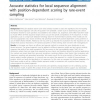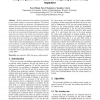ICASSP
2011
IEEE
14 years 4 months ago
2011
IEEE
We here address the problem of constructing sets of sequences with low integrated aperiodic auto- and crosscorrelations when the constraint of antipodal symbols is enforced. Our m...
121
Voted
BMCBI
2011
14 years 7 months ago
2011
Background: The number of gene sequences that are available for comparative genomics approaches is increasing extremely quickly. A current challenge is to be able to handle this h...
134
click to vote
NAR
2010
14 years 7 months ago
2010
Evaluating the accuracy of multiple sequence alignment (MSA) is critical for virtually every comparative sequence analysis that uses an MSA as input. Here we present the GUIDANCE ...
118
Voted
JCIT
2010
14 years 7 months ago
2010
Sequence mining is an important data mining task. In order to retrieve interesting sequences from a large database, a minimum support threshold is needed to be specified. Unfortun...
109
Voted
TIT
2011
14 years 7 months ago
2011
New families of near-complementary sequences are presented for peak power control in multicarrier communications. A framework for near-complementary sequences is given by the expl...
126
click to vote
PRL
2011
14 years 7 months ago
2011
This paper presents a robust technique for temporally aligning multiple video sequences that have no spatial overlap between their fields of view. It is assumed that (i) a moving...
139
Voted
NAR
2011
14 years 7 months ago
2011
The IMGT/HLA database (http://www.ebi.ac.uk/imgt/ hla) has provided a centralized repository for the sequences of the alleles named by the WHO Nomenclature Committee for Factors o...
160
Voted
BMCBI
2011
14 years 7 months ago
2011
Background: Molecular database search tools need statistical models to assess the significance for the resulting hits. In the classical approach one asks the question how probable...
136
Voted
BIOCOMP
2010
14 years 9 months ago
2010
We have elaborated a new method of recognizing protein coding sequences in genomic sequences. The method is exploiting a specific way of genetic code degeneration and relations bet...
138
Voted
BMCBI
2010
14 years 10 months ago
2010
Background: Traditional genome alignment methods consider sequence alignment as a variation of the string edit distance problem, and perform alignment by matching characters of th...



